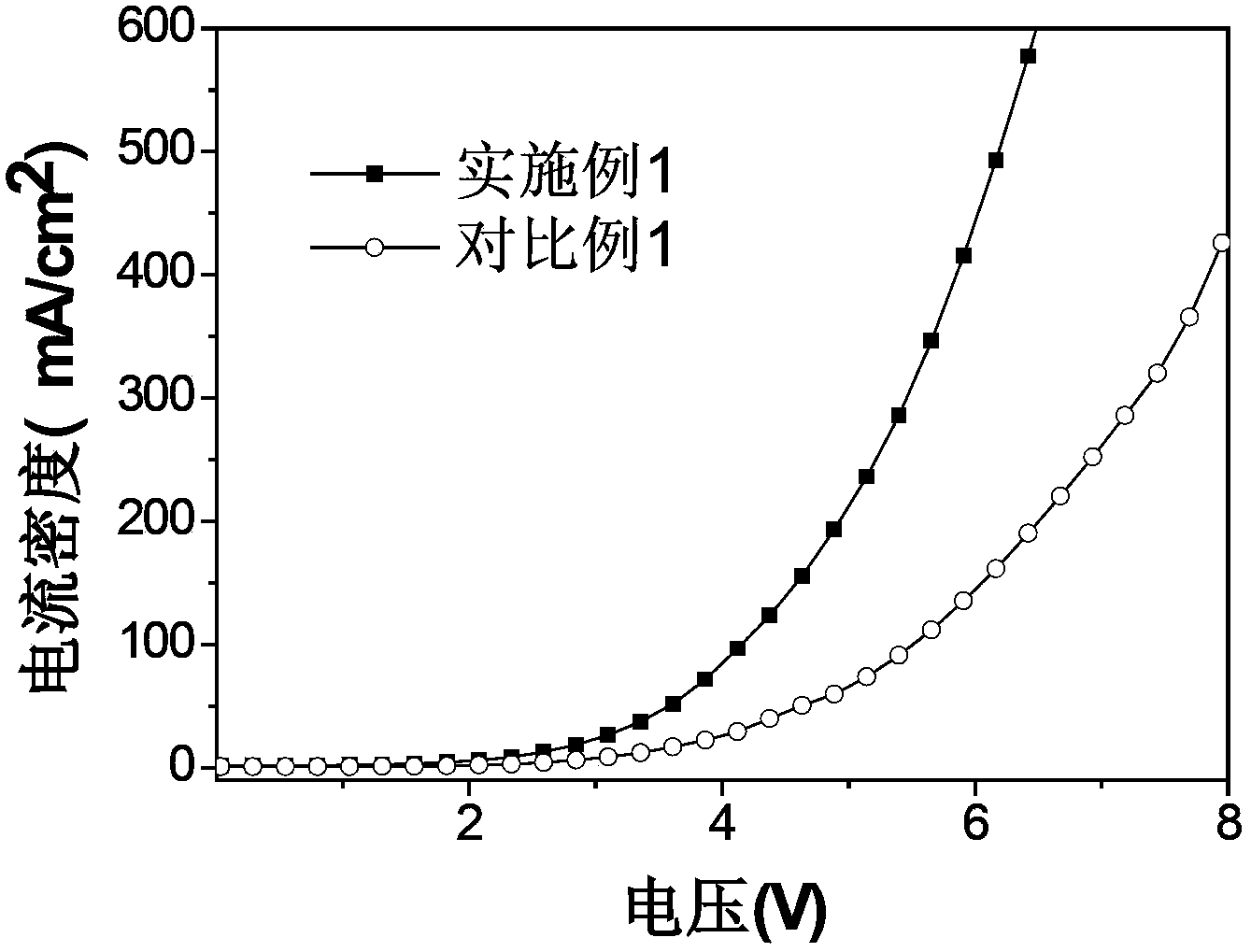Inverted organic light emission diode device and manufacturing method thereof
An electroluminescent device, an inverted technology, which is applied in the fields of electro-solid devices, semiconductor/solid-state device manufacturing, electrical components, etc., can solve the problems of high work function, unfavorable electron injection, and difficulty in improving the luminous efficiency of devices.
- Summary
- Abstract
- Description
- Claims
- Application Information
AI Technical Summary
Problems solved by technology
Method used
Image
Examples
Embodiment 1
[0048] The structure of the inverted organic electroluminescent device is: glass substrate / ITO(100nm) / CuI:CuPc(5%, 5nm) / F 16 CuPc(4nm) / Bphen(30nm) / DCJTB:Alq 3 (1%, 1nm) / NPB(30nm) / Ag(100nm).
[0049] The fabrication method of the inverted organic electroluminescent device of this embodiment includes the following steps:
[0050] Step 1: Provide a glass substrate, place the substrate in deionized water containing detergent for ultrasonic cleaning, and then use isopropanol and acetone to treat it in ultrasonic waves for 20 minutes, and then dry it with nitrogen.
[0051] Step 2. In a vacuum of 5×10 -4 In Pa's vacuum coating system, a layer of ITO film with a thickness of 100 nm was prepared on the surface of the substrate as the cathode layer by sputtering.
[0052] Step 3. In a vacuum of 5×10 -4 In Pa's vacuum coating system, the p-type layer and n-type layer of the pn junction layer are sequentially prepared on the surface of the cathode layer by thermal evaporation technol...
Embodiment 2
[0057] The structure of the inverted organic electroluminescent device is: glass substrate / AZO(70nm) / ZnI 2 :ZnPc(20%, 15nm) / F 16 ZnPc(10nm) / TPBi(60nm) / Ir(piq) 3 : CBP(8%,12nm) / 2-TNATA(60nm) / Al(70nm).
[0058] The fabrication method of the inverted organic electroluminescent device of this embodiment includes the following steps:
[0059] Step 1: Provide a glass substrate, place the substrate in deionized water containing detergent for ultrasonic cleaning, and then use isopropanol and acetone to treat it in ultrasonic waves for 20 minutes, and then dry it with nitrogen.
[0060] Step 2: In the vacuum coating system, prepare an AZO thin film with a thickness of 70 nm on the surface of the substrate as the cathode layer by sputtering.
[0061] Step 3. In a vacuum of 1×10 -3 In the vacuum coating system of Pa, the p-type layer and n-type layer of the pn junction layer are sequentially prepared on the surface of the cathode layer by thermal evaporation technology, wherein the m...
Embodiment 3
[0066] The structure of the inverted organic electroluminescent device is: glass substrate / GZO(200nm) / SnI 2 :VOPc(1%,4nm) / F 16 CuPc(1nm) / PBD(20nm) / Ir(ppy) 3 : CBP(10%,15nm) / m-MTDATA(20nm) / Au(200nm).
[0067] The fabrication method of the inverted organic electroluminescence device of the present embodiment comprises the following steps:
[0068] Step 1: Provide a glass substrate, place the substrate in deionized water containing detergent for ultrasonic cleaning, and then use isopropanol and acetone to treat it in ultrasonic waves for 20 minutes, and then dry it with nitrogen.
[0069] Step 2: In a vacuum coating system, prepare a GZO thin film with a thickness of 200 nm on the surface of the substrate as a cathode layer by sputtering.
[0070] Step 3. In a vacuum of 1×10 -5 In the vacuum coating system of Pa, the p-type layer and the n-type layer in the pn junction layer are sequentially prepared on the surface of the cathode by thermal evaporation technology, and the mat...
PUM
 Login to View More
Login to View More Abstract
Description
Claims
Application Information
 Login to View More
Login to View More - R&D
- Intellectual Property
- Life Sciences
- Materials
- Tech Scout
- Unparalleled Data Quality
- Higher Quality Content
- 60% Fewer Hallucinations
Browse by: Latest US Patents, China's latest patents, Technical Efficacy Thesaurus, Application Domain, Technology Topic, Popular Technical Reports.
© 2025 PatSnap. All rights reserved.Legal|Privacy policy|Modern Slavery Act Transparency Statement|Sitemap|About US| Contact US: help@patsnap.com


